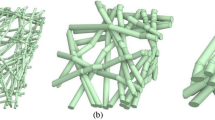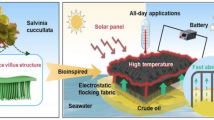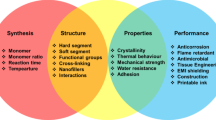Abstract
The effects of formulation variables, such as type of polyol, solvent type and solvent content, and coating application method, on the surface properties of siloxane–polyurethane fouling-release coatings were explored. Fouling-release coatings allow the easy removal of marine organisms from a ship’s hull via the application of a shear force to the surface. Self-stratified siloxane–polyurethane coatings are a new approach to a tough fouling-release coating system. Combinatorial High Throughput Experimentation was employed to formulate and characterize 24 different siloxane–polyurethane coatings applied using drawdown and drop-casting methods. The resulting coatings were tested for surface energy using contact angle measurements. The fouling-release performance of the coatings was tested using a number of diverse marine organisms including bacteria (Halomonas pacifica and Cytophaga lytica), sporelings (young plants) of the green macroalga (Ulva linza), diatom ((microalga) Navicula incerta), and barnacle (Amphibalanus amphitrite). The performance of the majority of the coatings was found to be better than the silicone standards, Intersleek® and Silastic® T2. An increase in solvent content in the formulations increased the surface roughness of the coatings. Coatings made with polycaprolactone polyol appeared to be somewhat rougher compared to coatings made with the acrylic polyol. The adhesion strength of sporelings of Ulva increased with an increase in solvent content and increase in surface roughness. The adhesion strengths of Ulva sporelings, C. lytica, and N. incerta were independent of application method (cast or drawdown) in contrast to H. pacifica adhesion, which was dependent on the application method.














Similar content being viewed by others
References
Yebra, DM, Kiil, S, Dam-Johansen, K, “Antifouling Technology-Past, Present and Future Steps towards Efficient and Environmentally Friendly Antifouling Coatings.” Prog. Org. Coat., 50 75–104 (2004)
Callow, ME, “Ship Fouling: Problems and Solutions.” Chem. Ind., 5 123–127 (1990)
Callow, ME, Callow, JE, “Marine Biofouling: A Sticky Problem.” Biologist, 49 10–14 (2002)
Schultz, MP, Bendick, JA, Holm, ER, Hertel, WM, “Economic Impact of Biofouling on a Naval Surface Ship.” Biofouling, 27 87–98 (2011)
Piola, RF, Dafforn, KA, Johnston, EL, “The Influence of Antifouling Practices on Marine Invasions.” Biofouling, 25 633–644 (2009)
Yamaguchi, T, Prabowo, RE, Ohshiro, Y, Shimono, T, Jones, D, Kawai, H, Otani, M, Oshino, A, Inagawa, S, Akaya, T, Tamura, I, “The Introduction to Japan of the Titan Barnacle, Megabalanus coccopoma (Darwin 1854) (Cirripedia: Balanomorpha) and the Role of Shipping in its Translocation.” Biofouling, 25 325–333 (2009)
Hopkins, GA, Forrest, BM, “A Preliminary Assessment of Biofouling and Non-Indigenous Marine Species Associated with Commercial Slow-Moving Vessels Arriving in New Zealand.” Biofouling, 26 613–621 (2010)
Kavanagh, CJ, Quinn, RD, Swain, GW, “Observations of Barnacle Detachment from Silicones Using High-Speed Video.” J. Adhes., 81 843–868 (2005)
Bullock, S, Johnston, EE, Willson, T, Gatenholm, P, Wynne, KJ, “Surface Science of a Filled Polydimethylsiloxane-Based Alkoxysilane-Cured Elastomer: RTV11.” J. Colloid Interf. Sci., 210 18–36 (1999)
Brady, RF, “Properties Which Influence Marine Fouling Resistance in Polymers Containing Silicon and Fluorine.” Prog. Org. Coat., 35 31–35 (1999)
Brady, RF, “A Fracture Mechanical Analysis of Fouling Release from Nontoxic Antifouling Coatings.” Prog. Org. Coat., 43 188–192 (2001)
Kohl, JG, Singer, IL, “Pull-off Behavior of Epoxy Bonded to Silicone Duplex Coatings.” Prog. Org. Coat., 36 15–20 (1999)
Adkins, JD, Mera, AE, Roe-Short, MA, Pawlikowski, GT, Brady, RF, “Novel Non-Toxic Coatings Designed to Resist Marine Fouling.” Prog. Org. Coat., 29 1–5 (1996)
Finnie, A, Williams, DN, “Paint and Coatings Technology for the Control of Marine Fouling.” In: Durr, S, Thomason, JC (eds.) Biofouling, p. 429. Wiley–Blackwell, Chichester, 2010
Ekin, A, Webster, DC, Daniels, JW, Stafslien, SJ, Casse, F, Callow, JA, Callow, ME, “Synthesis, Formulation and Characterization of Siloxane–Polyurethane Coatings for Underwater Marine Applications Using Combinatorial High-Throughput Experimentation.” J. Coat. Technol. Res., 4 435–451 (2007)
Majumdar, P, Webster, DC, “High-Throughput Combinatorial Characterization of Thermosetting Siloxane–Urethane Coatings Having Spontaneously Formed Microtopographical Surfaces.” J. Coat. Technol. Res., 4 131–138 (2007)
Sommer, S, Ekin, A, Webster, DC, Daniels, JW, Stafslien, SJ, Vander Wal, L, Thompson, SEM, Callow, ME, Callow, JA, “A Preliminary Study on the Properties and Fouling-Release Performance of Siloxane–Polyurethane Coatings Prepared from PDMS Macromers.” Biofouling, 26 961–972 (2010)
Ekin, A, Webster, DC, “Library Synthesis and Characterization of 3-Aminopropyl-Terminated Poly(dimethylsiloxane)s and Poly(ε-caprolactone)-b-poly(dimethylsiloxane)s.” J. Polym. Sci. Part A: Polym. Chem., 44 4880–4894 (2006)
Ekin, A, Webster, DC, “Synthesis and Characterization of Novel Hydroxyalkyl Carbamate and Dihydroxyalkyl Carbamate Terminated Poly(dimethylsiloxane) Oligomers and Their Block Copolymers with Poly(ε-caprolactone).” Macromolecules, 39 8659–8668 (2006)
Ekin, A, Webster, DC, “Combinatorial and High-Throughput Screening of the Effect of Siloxane Composition on the Surface Properties of Crosslinked Siloxane–Polyurethane Coatings.” J. Comb. Chem., 9 178–188 (2007)
Pieper, RJ, Ekin, A, Webster, DC, Casse, F, Callow, JA, Callow, ME, “A Combinatorial Approach to Study the Effect of Acrylic Polyol Composition on the Properties of Crosslinked Siloxane–Polyurethane Fouling-Release Coatings.” J. Coat. Technol. Res., 4 453–461 (2007)
Bodkhe, RB, Thompson, SEM, Callow, ME, Callow, JA, Webster, DC, “Effect of Siloxane Molecular Weight and Content on Fouling-Release Performance of Siloxane–Polyurethane Coatings Using Combinatorial High Throughput Methods.” PMSE Preprints, 99 376–377 (2008)
Bodkhe, RB, Thompson, SEM, Callow, ME, Callow, JA, Webster, DC, Fouling-Release Performance of Siloxane–Polyurethane Coatings using Combinatorial High-Throughput Methods. Materials Research Society (MRS), San Francisco, CA, 2009
Owens, DK, Wendt, RC, “Estimation of the Surface Free Energy of Polymers.” J. Appl. Polym. Sci., 13 1741–1747 (1969)
Chisholm, BJ, Webster, DC, Bennett, JC, Berry, M, Christianson, D, Kim, J, Mayo, B, Gubbins, N, “Combinatorial Materials Research Applied to the Development of New Surface Coatings VII: An Automated System for Adhesion Testing.” Rev. Sci. Instrum., 78 072213 (2007)
Webster, DC, Chisholm, BJ, Stafslien, SJ, “Mini-Review: Combinatorial Approaches for the Design of Novel Coatings systems.” Biofouling, 23 179–192 (2007)
Webster, DC, “Combinatorial and High Throughput Methods in Macromolecular Materials Research and Development.” Macromol. Chem. Phys., 209 237–246 (2008)
Webster, DC, Bennett, J, Kuebler, S, Kossuth, MB, Jonasdottir, S, “High Throughput Workflow for the Development of Coatings.” J. Coat. Technol., 1 34–39 (2004)
Webster, DC, “Radical Change in Research and Development: The Shift from Conventional Methods to High Throughout Methods.” JCT CoatingsTech, 2(15) 24–29 (2005)
Chisholm, BJ, Christianson, DA, Webster, DC, “Combinatorial Materials Research Applied to the Development of New Surface Coatings: II. Process Capability Analysis of the Coating Formulation Workflow.” Prog. Org. Coat., 57 115–122 (2006)
Chisholm, B, Potyrailo, R, Cawse, J, Shaffer, R, Brennan, M, Molaison, C, Whisenhunt, D, Flanagan, B, Olson, D, Akhave, J, Saunders, D, Mehrabi, A, Licon, M, “The Development of Combinatorial Chemistry Methods for Coating Development: I. Overview of the Experimental Factory.” Prog. Org. Coat., 45 313–321 (2002)
Nasrullah, MJ, Webster, DC, “Parallel Synthesis of Polymer Libraries Using Atom Transfer Radical Polymerization (ATRP).” Macromol. Chem. Phys., 210 640–650 (2009)
Chisholm, BJ, Potyrailo, RA, Cawse, JN, Shaffer, RE, Brennan, M, Molaison, CA, “Combinatorial Chemistry Methods for Coating Development: V. The Importance of Understanding Process Capability.” Prog. Org. Coat., 47 120–127 (2003)
Stafslien, SJ, Bahr, JA, Daniels, JW, Vander Wal, L, Nevins, J, Smith, J, Schiele, K, Chisholm, B, “Combinatorial Materials Research Applied to the Development of New Surface Coatings VI: An Automated Spinning Water Jet Apparatus For the High-Throughput Characterization of Fouling-Release Marine Coatings.” Rev. Sci. Instrum., 78 1–6 (2007)
Casse, F, Stafslien, SJ, Bahr, JA, Daniels, JW, Finlay, JA, Callow, ME, Callow, JA, “Combinatorial Materials Research Applied to the Development of New Surface Coatings V: Application of a Spinning Water-jet for the Semi-high Throughput Assessment of Attachment Strength of Marine Fouling Algae.” Biofouling, 23 121–130 (2007)
Stafslien, SJ, Daniels, JW, Mayo, B, Christianson, DA, Chisholm, BJ, Ekin, A, Webster, DC, Geoffrey, S, “Combinatorial Materials Research Applied to the Development of New Surface Coatings IV A High-Throughput Bacterial Biofilm Retention and Retraction Assay for Screening Fouling-Release Performance of Coatings.” Biofouling, 23 45–54 (2007)
Ribeiro, E, Stafslien, SJ, Cassé, F, Callow, JA, Callow, ME, Pieper, RJ, Daniels, JW, Bahr, JA, Webster, DC, “Automated Image-Based Method for Laboratory Screening of Coating Libraries for Adhesion of Algae and Bacterial Biofilms.” J. Comb. Chem., 10 586–594 (2008)
Rittschof, D, Orihuela, B, Stafslien, S, Daniels, J, Chisholm, B, Christianson, D, Holm, E, “Barnacle Reattachment: A Tool for Studying Barnacle Adhesion.” Biofouling, 24 1–9 (2008)
Bennett, SM, Finlay, JA, Gunari, N, Wells, DD, Meyer, AE, Walker, GC, Callow, ME, Callow, JA, Bright, FV, Detty, MR, “The Role of Surface Energy and Water Wettability in Aminoalkyl/Fluorocarbon/Hydrocarbon-Modified Xerogel Surfaces in the Control of Marine Biofouling.” Biofouling, 26 235–246 (2010)
Holland, R, Dugdale, TM, Wetherbee, R, Brennan, AB, Finlay, JA, Callow, JA, Callow, ME, “Adhesion and Motility of Fouling Diatoms on a Silicone Elastomers.” Biofouling, 20 323–329 (2004)
Peng, J, Yu, X, Hanfu, W, Yuming, Y, Binyao, L, Yanchun, H, “Solvent-Induced Microphase Separation in Diblock Copolymer Thin Films with Reversibly Switchable Morphology.” J. Chem. Phys., 120 11163–11170 (2004)
Yılgör, E, Yılgör, I, “Hydrogen Bonding: A Critical Parameter in Designing Silicone Copolymers.” Polymer, 42 7953–7959 (2001)
Ku, C, Lee, Y, “Microphase Separation in Amorphous Poly(imide siloxane) Segmented Copolymers.” Polymer, 48 3565–3573 (2007)
Stefanis, E, Panayioto, C, “Prediction of Hansen Solubility Parameters with a New Group-Contribution Method.” Int. J. Thermophys., 29 568–585 (2008)
Majumdar, P, Webster, DC, “Surface Microtopography in Siloxane–Polyurethane Thermosets: The Influence of Siloxane and Extent of Reaction.” Polymer, 48 7499–7509 (2007)
Pike, JK, Ho, T, Wynne, KJ, “Water-Induced Surface Rearrangements of Poly(dimethylsiloxane–urea–urethane) Segmented Block Copolymers.” Chem. Mater., 8 856–860 (1996)
Acknowledgments
The authors would like to thank the Office of Naval Research for supporting this research under grants N00014-08-1-1149, N00014-09-1-1103, and N0014-11-1-1001. The authors would also like to thank David A. Christianson for his assistance with use of combinatorial high-throughput instruments, and Daniel Rittschof and Beatriz Orihuela of the Duke University Marine Laboratory (Beaufort, NC) for supplying adult barnacles.
Author information
Authors and Affiliations
Corresponding author
Additional information
This paper was tied for Third Place in the John A. Gordon Best Paper award competition at the 2011 CoatingsTech Conference, sponsored by the American Coatings Association, on March 14–16, 2011.
Rights and permissions
About this article
Cite this article
Bodkhe, R.B., Thompson, S.E.M., Yehle, C. et al. The effect of formulation variables on fouling-release performance of stratified siloxane–polyurethane coatings. J Coat Technol Res 9, 235–249 (2012). https://doi.org/10.1007/s11998-011-9362-x
Published:
Issue Date:
DOI: https://doi.org/10.1007/s11998-011-9362-x




